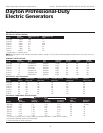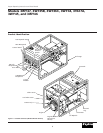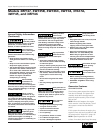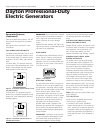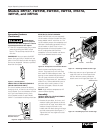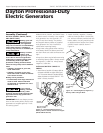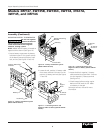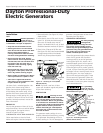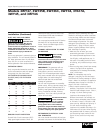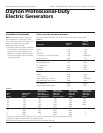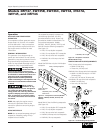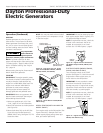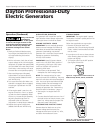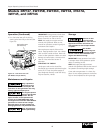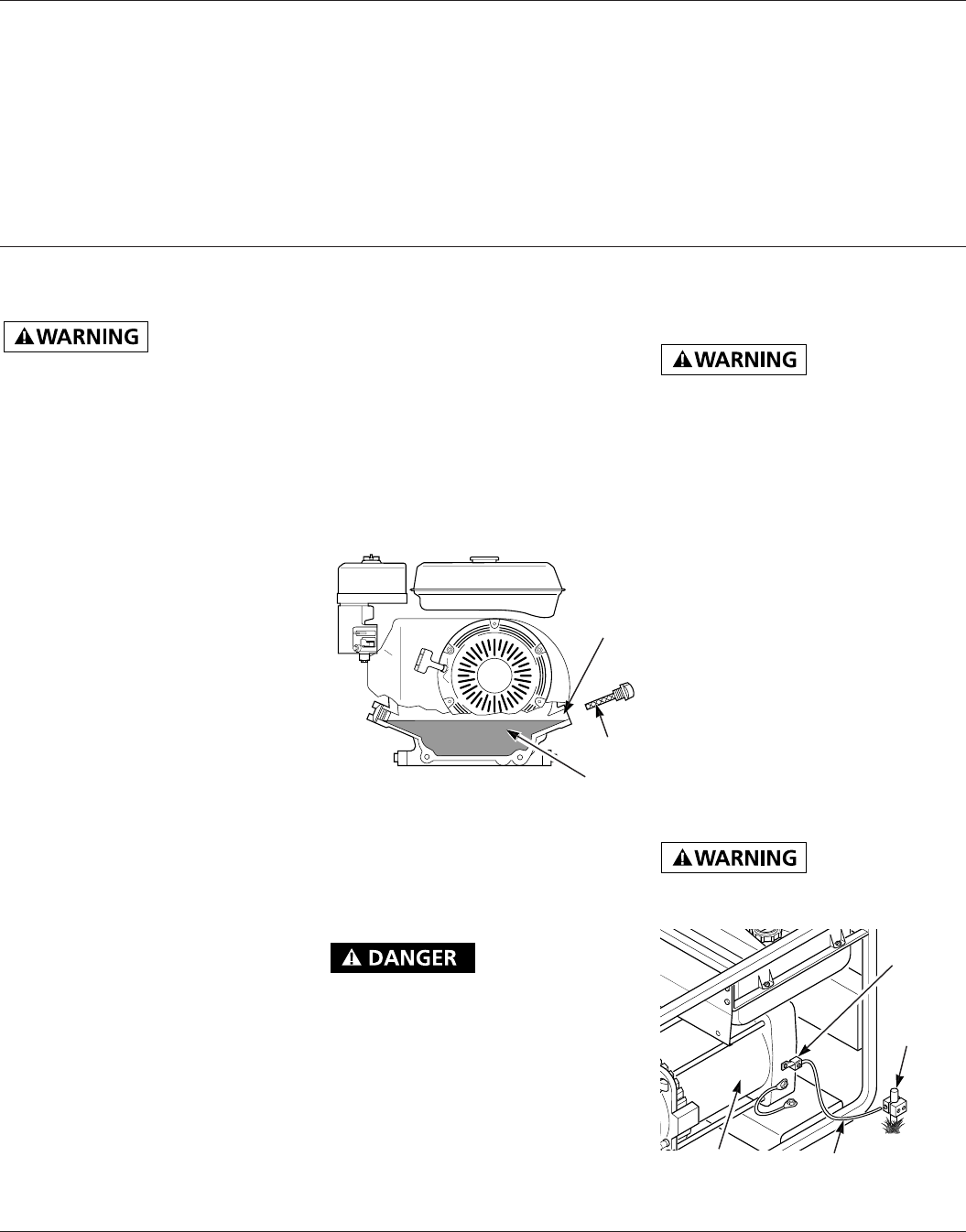
Dayton Operating Instructions and Parts Manual 3WY47, 3W735B, 3W736C, 3WY44, 3TE27A, 3WY45, and 3WY46
10
Dayton Professional-Duty
Electric Generators
®
Installation
FUEL
Gasoline presents a
hazard of fire or
explosion. Gasoline
is flammable. Its vapor is explosive.
• Keep fuel out of children’s reach.
• Refuel generator in a well-vented
area. Do not fill fuel tank in the dark.
Do not refuel while engine is
running. Unhook all electrical loads
and shut off engine before refueling.
• Do not overfill fuel tank. Always
allow room for fuel to expand. If you
overfill tank, fuel can overflow onto
hot engine. This can cause fire or
explosion. After refueling, tightly
close fuel tank cap.
• Do not spill fuel. Fuel or fuel vapor
may ignite. If fuel spills, make sure
area is dry before starting engine.
• Never smoke in refueling area. Never
allow open flames or sparks in area.
• Store fuel in approved container.
Store fuel in a well-vented area free
of open flames or sparks.
Use clean, fresh, unleaded gasoline. Use
gasoline with octane rating of 86 or
higher. Service station gasoline pumps
should display the octane rating. Using
gasoline with lower octane level could
damage engine. Avoid getting dirt, dust,
or water in fuel tank. Do not mix oil with
gasoline. See engine owner’s manual for
more information.
ENGINE OIL
We ship the generator without oil in the
engine crankcase. You must add oil before
starting engine. See engine owner’s
manual for specific oil type.
CHECKING OIL LEVEL AND ADDING OIL
Follow steps below to check oil level.
Make sure engine is level and stopped.
1. Remove dipstick (See Figure 19). Wipe
dipstick clean.
2. Insert dipstick into oil filler neck. Do not
screw it in. Oil level should be at top of
filler neck. Oil should cover most of
dipstick. For Model 3WY47 only, oil level
should be between two dots on dipstick.
3. If level is low, fill to top of oil filler neck
(See Figure 19). Only use oil recommended
in engine owner’s manual. For Model
3WY47 only, fill to top dot on dipstick.
Oil
Oil Level
At Top
Of Filler
Neck
Dipstick
Figure 19 – Checking Oil Level (Model
3W735B Shown)
VENTILATION
Use only in well-
vented areas. Make
sure area has plenty of free-moving,
fresh, outside air. Never run generator
in an enclosed or confined area. Never
run generator inside occupied building.
Engine exhaust contains poisonous
carbon monoxide gas. Overexposure
will cause loss of consciousness and
will lead to death.
This generator needs cooling air to run
properly. Never block free-flowing, cooling
air to generator. Overheating will occur
without cooling air. This will damage the
GENERATOR GROUNDING
You must properly
earth-ground
generator before starting. This will
help guard against deadly electric
shock. Only use grounded plugs with
generator. Only use grounded exten-
sion cords. Only use three-wire or
double-insulated power tools.
Grounding generator helps prevent electric
shock from a ground fault condition.
Locate ground lug on end of generator
housing (See Figure 20). Attach a #10
stranded-copper ground wire to ground
lug. Drive grounding point into ground.
Grounding point can be a stake, ground-
ing rod, or pipe. Grounding point should
be copper or brass. Attach ground wire to
grounding point. You must supply the
ground wire and grounding point. These
do not come with generator. Follow the
National Electrical Code and all state and
local codes. Consult your power company
or a licensed electrician.
Copper or
Brass
Grounding
Point
Ground
Lug
Alternator
Ground Wire
For a grounding
point, do not use
metal pipe being used to carry combus-
tible materials or gases.
Figure 20 – Grounding Generator
(Model 3WY45 Shown)
generator. Keep generator at least three
feet away from any object.
NOTE: If oil level is too low, oil alert
system will shutdown engine and prevent
engine from restarting.



